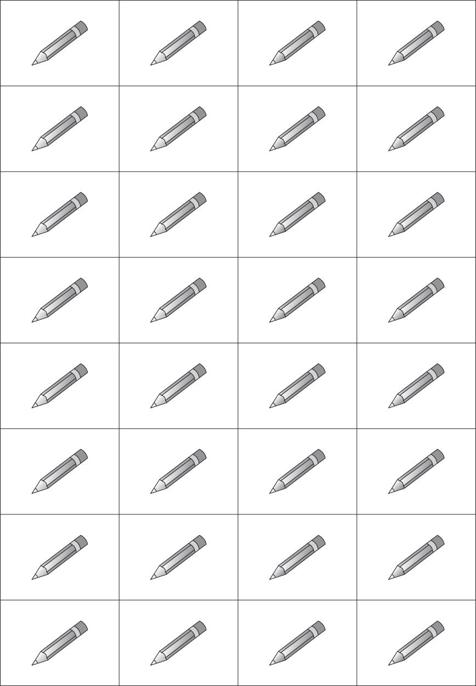Teaching the Common Core Math Standards With Hands-On Activities, Grades 3-5 (26 page)
Read Teaching the Common Core Math Standards With Hands-On Activities, Grades 3-5 Online
Authors: Judith A. Muschla,Gary Robert Muschla,Erin Muschla-Berry
Tags: #Education, #Teaching Methods & Materials, #Mathematics, #General

BOOK: Teaching the Common Core Math Standards With Hands-On Activities, Grades 3-5
11.58Mb size Format: txt, pdf, ePub
Procedure
1.
Divide your class into ten groups and explain that each group will make a place-value model, using a certain number of “picture” pencils to show the value of each place. Students will then work as a class to complete a larger place-value model.
2.
Distribute four copies of the reproducible to each group.
3.
Instruct students to cut out 1 pencil. This represents 1. They should set it aside for now.
4.
Instruct students to form a column of 10 pencils. Suggest that they cut out two pencils from the reproducible they used for cutting out the pencil for the ones place. Instruct students to glue the two pencils at the bottom of a column on another of the reproducibles. This column now represents tens. They should cut out this column and set it aside.
5.
Instruct students to make 10 columns of 10, which represent 100. They should glue the columns together (along their edges). Suggest that they cut out two rows of pencils from two of the copies and glue them at the bottom of the columns of eight pencils on the other two copies, to create 10 rows.
6.
Instruct students to place their 1 pencil, column of 10 pencils, and columns of 100 pencils beside each other on a desk. Explain that they have a created a place value model for ones, tens, and hundreds. Emphasize that the value of each place represents 10 times the value of the place to its right.
7.
Explain that, as a class, you will now construct a place value model for ones, tens, hundreds, and thousands.
8.
Start with the ones. Ask a student to attach 1 pencil (with masking tape, mounting tape, or other material) to the surface on which you will display the model. This represents the ones place.
9.
Next ask a student to attach a column of 10 on the surface for the model. This column represents the tens place.
10.
Now ask for volunteers to attach 10 columns of 10 on the surface. These columns represent the hundreds place.
11.
Ask how many groups of 100 are needed to make 1,000. Students should answer 10. Ask for volunteers to attach 10 groups of 100 to the surface. These groups represent the thousands place.
12.
Use card stock to label each place value, and attach the labels above the proper columns to complete a place value chart of ones, tens, hundreds, and thousands. Seeing the visual representation will help students to understand the powers of 10.
Closure
Ask students if they were surprised by the quantities in each group. Why or why not? Ask: How do the quantities change as you move in place value from right to left? Left to right? Emphasize that a digit in one place is 10 times what it represents in the place to its right.
Picture Pencils
Number and Operations in Base Ten: 4.NBT.2
“Generalize place value understanding for multi-digit whole numbers.”
2. “Read and write multi-digit whole numbers using base-ten numerals, number names, and expanded form. Compare two multi-digit numbers based on meanings of the digits in each place, usingand
symbols to record the results of comparisons.”
Background
Numbers can be represented in three ways: word form, numerical form, or in expanded form. For example:
- Word form: Fifty-two thousand, six hundred forty-nine
- Numerical form: 52,649
- Expanded form:

Activity: Expressing Numbers
Working in pairs or groups of three, students will represent a number in three different forms. They will then select any two pairs of numbers and compare them using the inequality symbols,or
Materials
Scissors; glue sticks; one sheet of large construction paper; reproducible, “Number Form Cards,” for each pair or group of students.
Procedure
1.
Distribute copies of the reproducible and explain that it contains eight rows. The first six rows contain six cards each, and the last two rows contain three cards each. The cards in the first row contain numbers in standard form. The cards in the second through sixth rows contain parts of the numbers, written in expanded form. When combined correctly, they will match the numbers in the first row. The cards in the last two rows contain the word forms of numbers in the first row.
2.
Explain that students should cut out the cards.
3.
Next explain that they are to arrange the cards on their construction paper so that each number in the first row is represented by its expanded form and word form.
4.
After arranging their cards, students should glue them on their construction paper.
5.
Explain that after gluing their cards, students are to compare two pairs of the numbers they worked with. One pair of numbers is to be compared using thesymbol. The other pair of numbers is to be compared using the
symbol. Students should write their comparisons at the bottom of their construction paper.
Other books
TW04 The Zenda Vendetta NEW by Simon Hawke
The Ebbing Tide by Elisabeth Ogilvie
The Shadow Dragons by James A. Owen
A Witch In Winter by Ruth Warburton
My Fight to the Top by Michelle Mone
The Price We Pay by Alora Kate
Highways & Hostages by Jax Abbey
La voz dormida by Dulce Chacón
Young Lies (Young Series Book 1) by W.R. Kimble
Five Golden Rings (Facets of Passion) by Kennedy, Jeffe



